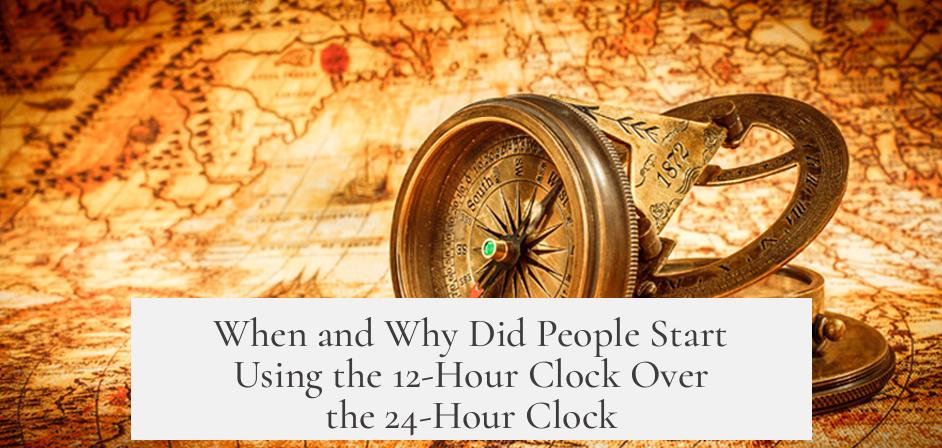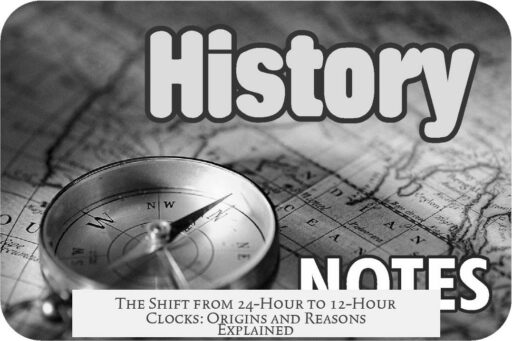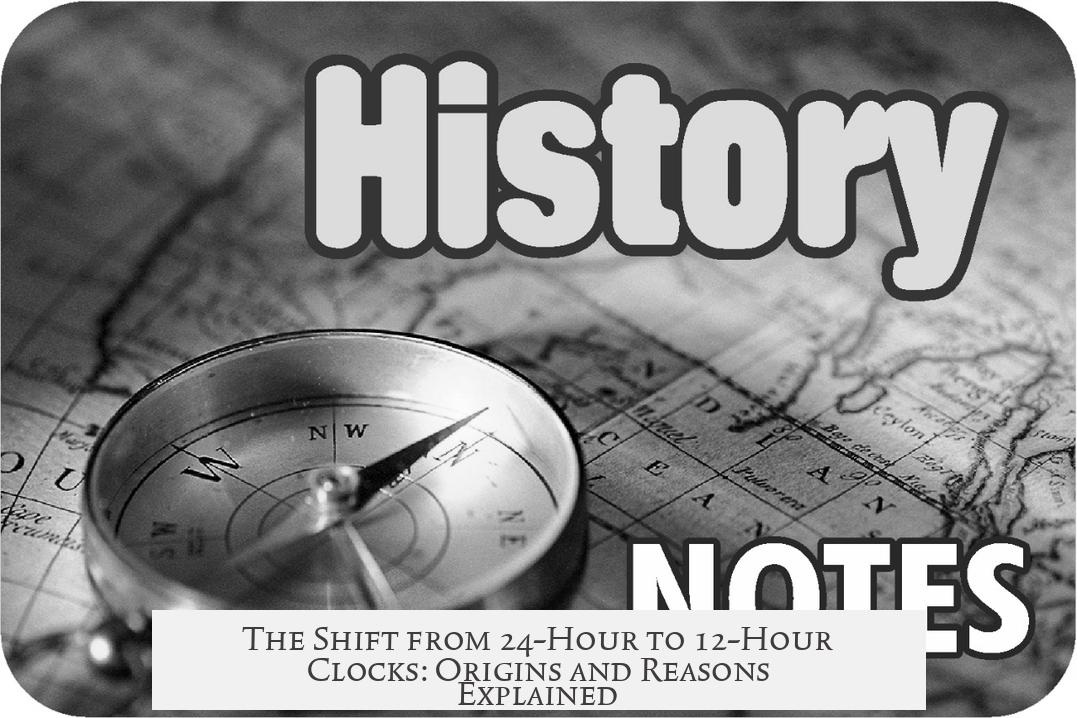The 12-hour clock originated thousands of years ago, long before the 24-hour clock appeared. Ancient Egyptians first used a 12-hour timekeeping system over 3,000 years ago, relying on sundials that divided daylight and nighttime into twelve segments each. This system was later adopted by the Greeks and Romans, who marked hours according to the sun’s position. The 24-hour clock emerged much later, coinciding with the invention of mechanical clocks in Italy during the 1300s.
The 12-hour clock’s roots trace back to ancient Egypt, where they used sundials dividing day and night into 12 hours each. This division aligned with observable natural cycles, making it practical for daily life. The daylight hours varied in length with the seasons, as an hour represented one-twelfth of the daylight period, causing longer hours in summer and shorter in winter.
Greeks and Romans adopted and refined this system. Romans, in particular, counted hours from sunrise and sunset—for example, “prima” was the first hour after sunrise. This approach made timekeeping relative to natural light, which suited agrarian and religious activities dependent on daylight.
The 24-hour clock appeared much later with mechanical clocks in the 14th century. Unlike sundials, mechanical clocks could measure fixed hours, irrespective of daylight length. Early mechanical clocks often displayed 24-hour faces, reflecting a continuous count of hours from midnight to midnight. Despite this, the 12-hour system remained predominant for everyday use, possibly due to tradition and its alignment with human activity cycles.
Overall, the use of the 12-hour clock over the 24-hour format comes from its deep historical roots and natural alignment with daylight and night. The 24-hour clock’s later invention and technical nature made it more suitable for specialized or scientific contexts initially. The 12-hour clock persists because it matches daily human routines and has cultural familiarity.
- Ancient Egyptians invented the 12-hour clock using sundials.
- Greeks and Romans adopted a 12-hour day-night system with variable hour lengths.
- The 24-hour clock emerged with mechanical clocks in the 1300s Italy.
- 12-hour timekeeping aligned better with natural daylight cycles.
- The 12-hour clock remains widely used due to tradition and practicality.
When and Why Did People Start Using the 12-Hour Clock Over the 24-Hour Clock?

People started using the 12-hour clock thousands of years ago, long before the 24-hour clock existed. The ancient Egyptians first introduced it over 3,000 years ago with their sundials, and the system spread through the Greeks and Romans—making the 12-hour clock the original time tracker, while the 24-hour clock only emerged with mechanical clocks around the 1300s.
Now, let’s unravel the story behind how this came to be. If you’ve ever wondered why we say “AM” and “PM,” or why clocks tend to split the day into two halves instead of one long stretch—read on. This tale involves sundials, ancient civilizations, and the slow crawl of technology.
Ancient Beginnings: The 12-Hour Clock’s Dawn
The journey begins in ancient Egypt, around 3,000 years ago. Archaeologists recently uncovered a 12-hour Egyptian sundial, proving that the Egyptians used the 12-hour system to divide the day. Picture it: tracking time by the sun’s movement on a shadow while folks went about their farming or trading.
This wasn’t just an isolated Egyptian quirk. The ancient Greeks and Romans also adopted a similar system. They split daylight into 12 hours and night into another 12. So, instead of thinking of one continuous 24-hour cycle, they mentally sliced the day into two parts—daytime and nighttime—each with their own set of 12 hours.
Romans had a neat way to label time: the hour right after sunrise was called prima (meaning first). An hour or two later, you hit tertia (third hour), and so on. This system was practical because they counted hours starting at sunrise or sunset, depending on the time of day.
Variable Length Hours: The Secret Quirk of Ancient Timekeeping
Here’s a twist: the Romans did something we rarely see today—they changed the length of an hour depending on the season. Each hour was exactly one-twelfth of the daylight period, so summer hours were longer than winter ones. Imagine your hour getting shorter and longer like a stretching rubber band through the year.
This might sound confusing now, but in their world it made sense. Clocks weren’t mechanical yet; sundials ruled the day, and the sun’s path shifted with seasons. So, time measurement adjusted naturally. This isn’t like today’s steady 60-minute hour—ancient hours flexed with nature.
The Mechanical Revolution and the 24-Hour Clock’s Arrival

Fast forward to around the 1300s in Italy. Mechanical clocks popped up, and with them, the 24-hour clock made its debut. This is significant because it represents the first time people used a clock face showing all 24 hours continuously—no splitting between day and night.
So, why *did* the 12-hour clock remain dominant if the 24-hour option existed? Well, for starters, mechanical clocks were rare and expensive. The 12-hour system was already deeply rooted in daily life, language, and culture. It had been around for millennia, so people were accustomed to it.
The 24-hour clock was simply too novel and complex for common use at the time. Imagine explaining “hundred and fourteenth hour of the day” to someone used to “two o’clock in the afternoon.” It’s easier to keep the traditional split.
Why Stick to the 12-Hour Clock?
Practicality plays a big role. The 12-hour clock divides the day into two equal halves, making it straightforward to say “8 AM” or “8 PM”—clear and specific. For centuries, this suited everyday life perfectly.
Language reflects that, too. Even now, we add “AM” for morning and “PM” for afternoon or evening to clarify which half of the day we mean. Without this, confusion would run rampant.
Moreover, ancient and medieval societies were more focused on natural cycles—daytime for work, nighttime for rest. The 12-hour system matches human activity patterns better than a continuous 24-hour count.
What About the 24-Hour Clock Today?
The 24-hour clock gained traction much later, mainly because of modern needs. Military, aviation, hospitals, and many international contexts prefer the 24-hour clock to avoid ambiguity.
Still, the 12-hour clock is everywhere. Your kitchen clock, watches for casual wear, and daily chitchat still favor 12 hours divided into AM and PM.
Why? Because it’s familiar, easy, and embedded in our culture. You don’t have to mentally convert “1430 hours” to “2:30 in the afternoon” every day. It’s simple, user-friendly.
Lessons From Time’s Tale

Timekeeping isn’t just about numbers on a dial. It’s about human habits, culture, and what fits daily routine. The 12-hour clock’s endurance shows how deeply time is linked to nature and social norms.
Before mechanical innovation, people didn’t need the exactitude of continuous 24 hours. Sundials flexed with sunlight. The clock we use tells a story as old as civilization.
So next time you check a clock, remember: you’re using a tradition that dates back over three millennia. Isn’t it amazing how something so old is still part of your modern day?
Summary Table: 12-Hour vs. 24-Hour Clock Origins
| Feature | 12-Hour Clock | 24-Hour Clock |
|---|---|---|
| Origin | Ancient Egypt, 3,000+ years ago | Italy, 1300s (Mechanical clocks) |
| Time Division | Two sets of 12 hours (day & night) | Continuous 24 hours |
| Hour Length | Variable (dependent on daylight duration) | Fixed (60 minutes each) |
| Use Cases | Everyday life, cultural routine | Military, aviation, technical contexts |
Ready to impress your friends at the next trivia night? Now you’ve got the full backstory on why we use a 12-hour clock instead of a 24-hour one for most of daily life. Time isn’t just ticking. It’s a fascinating part of history.
When did the 12-hour clock first come into use?
The 12-hour clock dates back over 3,000 years with ancient Egyptians using a 12-hour sundial. Greeks and Romans also used a similar system dividing daytime and nighttime into 12 hours each.
Why did ancient peoples prefer the 12-hour system?
The 12-hour system matched the natural division of day and night. Egyptians divided the daylight into 12 parts, which fit the sun’s movement. This made timekeeping practical using sundials.
How did the 24-hour clock emerge compared to the 12-hour clock?
The 24-hour clock appeared around the 1300s with the invention of mechanical clocks in Italy. It came much later, nearly two thousand years after the 12-hour sundial was first used.
Why was the 24-hour clock invented so much later?
The 24-hour clock needed mechanical clocks to function well, which appeared long after the simple sundials used for 12 hours. The technology of the time limited earlier use of a 24-hour system.
Did the length of hours vary with the 12-hour system?
Yes, in ancient times an hour was one-twelfth of daylight or night. This meant an hour in summer was longer than an hour in winter since day length changed with seasons.




